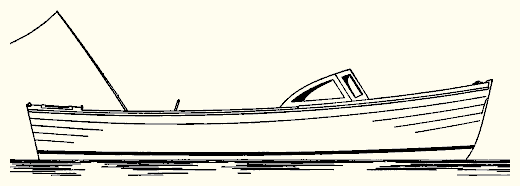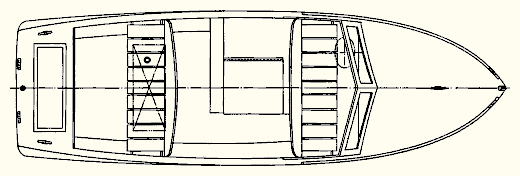

It may be of interest to mention that a sea skiff is a round-bilge boat having the usual vertical keel and deadwood. In other words, in model the sea skiff is the conventional type of motorboat in general use. Scamp, this latest of MoToR BoatinG's large family of boats, is a sea skiff. There is always confusion between the characteristics of a sea skiff and a Seabright skiff. This confusion is further complicated by folks sometimes describing a sea skiff as a Jersey skiff. I would say that a Jersey skiff is a flat-bottomed boat such as those used for hand-raking clams and in other similar water pursuits. A boat quite unlike Scamp. A Seabright skiff is a round-bilge, or sometimes V-bottomed boat. Rather than the vertical keel and deadwood the Seabright skiff has a box, or hollow deadwood; and the keel, rather than being vertical, is flat in an athwartship direction and either straight or slightly curved in a fore and aft direction. Both the sea skiff and Seabright skiff are excellent seagoers and can be depended upon to perform exceptionally well in either rough or smooth water; correctly designed they will be dry, safe and comfortable in any kind of going. And now, with the differences between a sea skiff and a Seabright skiff briefly outlined, let's turn to the matter at hand -- the subject of this month's design -- Scamp. Here we have a modern looking yet practical kind of small boat. A boat designed particularly for fishing in and out of difficult inlets and a boat which can be used for various and sundry uses, for instance: picnics, livery service, island inter-communication, delivery purposes, and plain everyday fun afloat.

The over all length of the new member of the family is 19 feet 6 3/4 inches; the water line length is 18 feet; the breadth at the deck, 6 feet 9 inches; and the draft to the bottom of the keel, 1 foot 5 1/2 inches. The freeboard at the bow is 3 feet 1 1/2 inches; the least freeboard, 2 feet 0 inches; and at the stern, 2 feet 2 inches. She will be a much larger boat when completed than the drawings indicate. Scamp will be a wholesome lump of boat and, judging from a near relation, an excellent one as well.
The near relation, fifteen years removed, is Timmy High. Between the old relation and the new there are many differences not least of which are the long keel and deadwood rather than the bronze strut and exposed propeller shaft, increased length and freeboard, a bolder sheer line, and a greatly changed arrangement of the deck and cockpit. The latest design also shows a much stronger hull than the 1939 model. All the proven characteristics of Timmy High are, however, retained and this new boat, Scamp, will prove to be of a superior type.

The deck arrangement of Scamp shows the motor in a house about amidship. The house extends over the motor outboard and leaves the starboard side open as a passageway to the forward cockpit. The forward seat is 5 feet 9 inches in width; ample room for three to sit in comfort. The steering wheel is of the conventional automobile type with attached motor controls. The forward end of the cockpit is nicely protected against wind and spray by the fixed windshield shown. The after end of the cockpit is furnished with a full-width seat; the lazy back for this is removable and can be easily changed to form a backrest for passengers facing forward or for fishermen facing aft. There is a fish box, or well, under the aft deck.

The motor shown in the plans is a Scripps Series 30; cylinder displacement, 134 cubic inches, developing 50 h.p. at 3200 r.p.m.; or 60 h.p. at 3400 r.p.m. (Scripps Series 4-60). The speed, with the 60 h.p. motor will be a good 22 m.p.h. Universal, Gray, Red Wing, Palmer, Kermath, Lathrop, and several other motor manufacturers produce comparable power units, all well suited for Scamp.